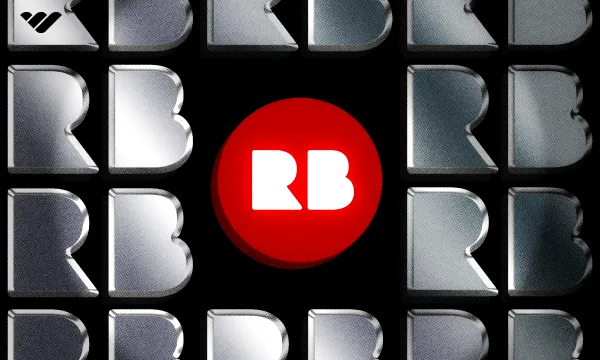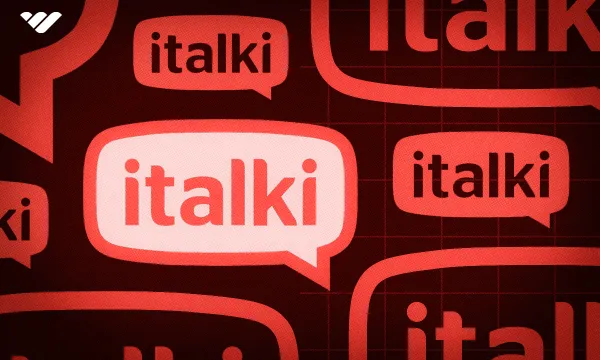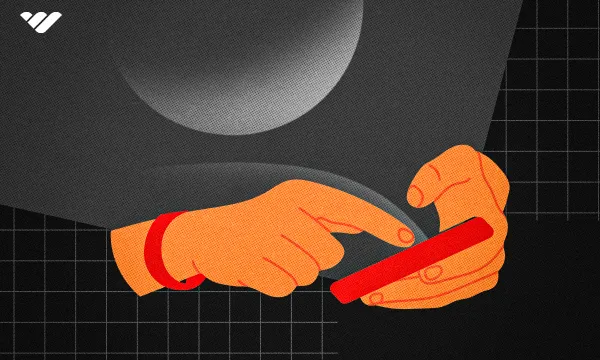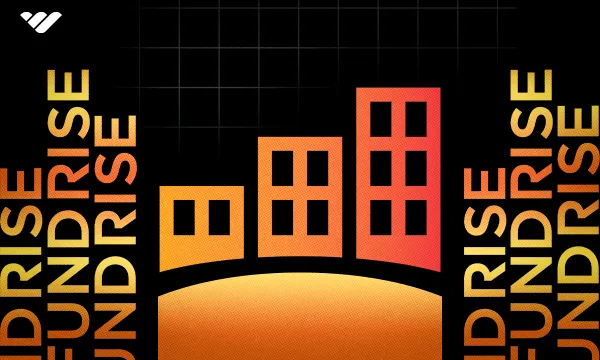Do you dream of turning your passion for art into a profitable business? If yes, selling online can open doors to a global audience. But with so many platforms to choose from, it can be tough to know where to start considering each platform is slightly different from the other.
Redbubble has long been a popular choice for artists looking to sell their designs on various products. You upload your art, Redbubble handles everything else, and you get a check at the end of the month. But is it the right platform for you?
In this review, we'll discuss Redbubble's pros and cons, explore its new fee structure, and help you decide if it's the right fit for your artistic journey. We’ll also show you how to create an account, upload your artwork, change the profit margin, and get your hands on your hard-earned money.
What is Redbubble?
Redbubble is a popular online marketplace that connects artists and designers selling print-on-demand (POD) products with a global audience. By uploading your original artwork, creators like you can see your designs transformed into a wide range of items, from clothing to wall art and more.
Artists can use Redbubble without upfront costs or membership fees. Their goal is “giving independent artists a meaningful way to sell their creations.”
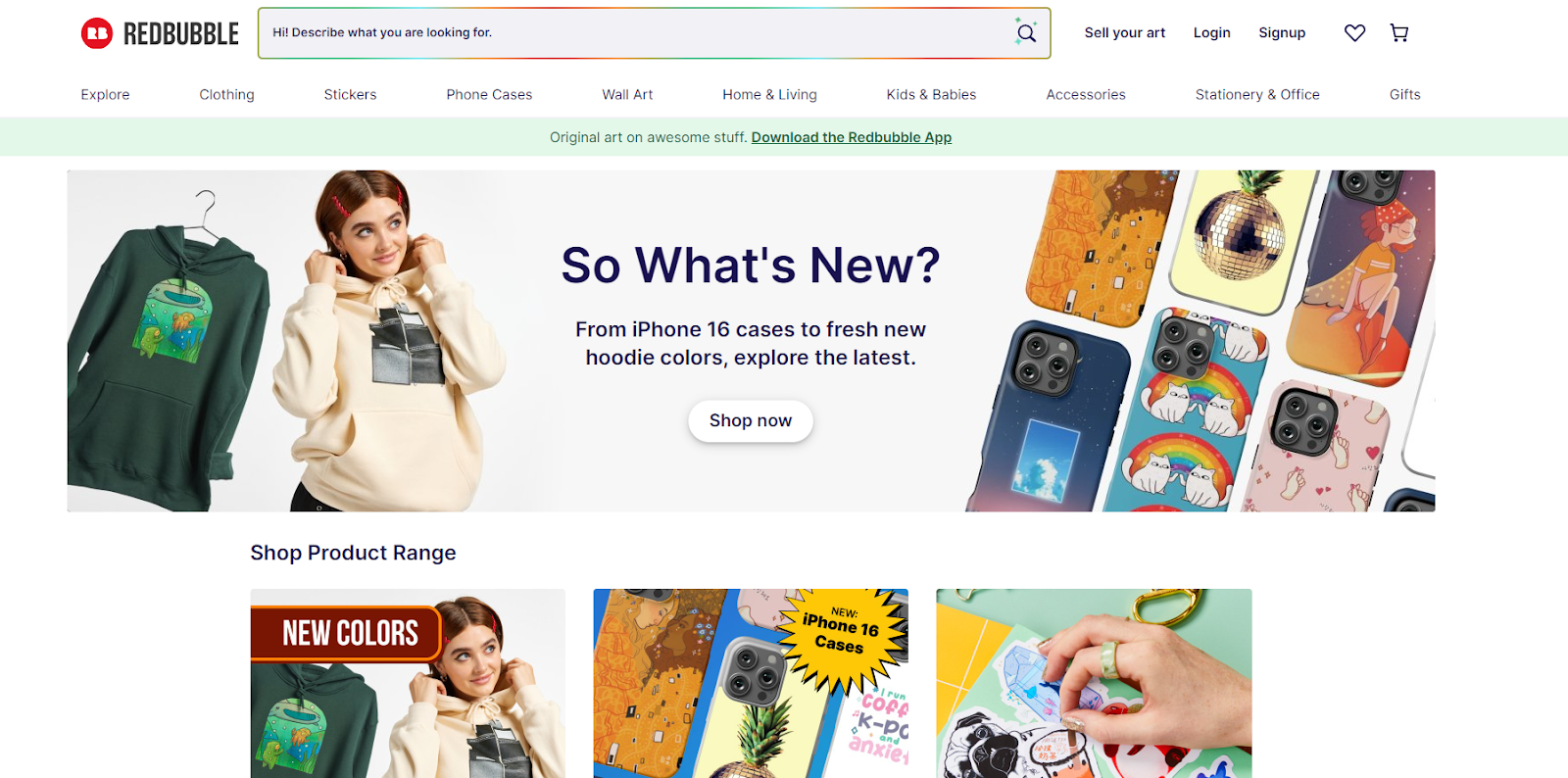
Founded in 2006 in Melbourne, Australia, Redbubble has gone through significant growth over the years. In fiscal year 2023, the platform served 5 million customers and featured designs from 650,000 artists worldwide. They have over 40 million monthly site visitors.
It's worth noting that Redbubble also owns TeePublic, another popular print-on-demand platform. Together, these platforms have generated over $100 million in customer sales in over 200 countries. Redbubble's international customer base provides a vast market for artists to sell their designs.
With over 70 product types, ranging from clothing and gifts to wall art, Redbubble offers plenty of options to showcase your work. You also have the flexibility to set your own profit margins on each product, and Redbubble offers watermark and anti-piracy features to protect your designs.
Is Redbubble Legit?
The recent introduction of a tiered account system and revised fee structure at Redbubble has ignited a heated debate among artists. Many feel that the new tier system and fees are unfair, especially for those just starting out, and the criteria for qualifying for higher tiers are unclear and frustrating.
However, while concerns about Redbubble's profitability have grown, substantial evidence supports its status as a legitimate platform.
- Lots of positive user feedback: Redbubble regularly gets favorable customer feedback on websites like Trustpilot, which suggests that its services and goods are well-liked. They have an average rating of 3.7 stars from over 27,405 reviews on Trustpilot.
- Safe payment portals: To guarantee that artists get paid and purchasers' financial information is safe, Redbubble allows direct bank transfers and works with trustworthy payment processors like PayPal.
- Copyright protection: Redbubble has a strong framework for evaluating submitted designs and handling copyright infringement claims, providing artists with some security and action against unapproved usage of their creations.
Who Can Sell With Redbubble?
Redbubble offers a platform for anyone with a creative spark to sell their designs and make some extra money online. From seasoned artists to hobbyists and aspiring designers, anyone can open a shop and start sharing their work with the world. It's that easy with the help of Redbubble.
As an artist, if you have a high-end product, you can decide the price, and for buyers, you get to pick a suitable product format, for example, print, canvas, framed, etc. Here's who is best suited to Redbubble:
- Artists and designers: If you're a creative individual looking for a platform to sell your artwork, Redbubble offers a convenient way to reach a global audience. By signing up, you will get access to their huge user base of 40 million monthly visitors.
- Hobbyists and aspiring entrepreneurs: Even if you're just starting out, Redbubble provides a low-barrier entry point to explore your entrepreneurial side and monetize your creativity. It requires no financial investment from your side, so you don’t have to lose money making products no one will buy.
- Those seeking passive income: Redbubble's print-on-demand model allows you to earn passive income from your designs, even while you're pursuing other endeavors.
- People who want to showcase their work: If you simply want to share your art with the world and get like-minded people to purchase it, Redbubble is a great platform for doing so.
Essentially, anyone wanting to turn their artistic passion into a business or simply share their work with others can benefit from Redbubble.
What Can You Sell With Redbubble?
Redbubble is a print-on-demand platform, meaning you don't need to handle physical products yourself. Instead, your artwork is printed onto a variety of items and shipped directly to customers.
The product range on Redbubble includes 70 unique products, not limited to:
- Clothing: T-shirts, hoodies, leggings, mini skirts, and more.
- Kids and babies: Onesies, kids' pullover hoodies, masks, and t-shirts, baby t-shirts, and children's apparel.
- Phone cases: Cases for various smartphone models.
- Stickers: Vinyl stickers in different sizes and shapes.
- Wall art: Canvas prints, metal prints, posters, framed prints, mounted prints, and more.
- Home and living: Acrylic blocks, bath mats, aprons, bedding, clocks, coasters, magnets, shower curtains, mugs, jigsaw puzzles, pillows/cushions, and more.
- Stationery and office: Greeting cards, postcards, mouse pads/desk mats, hardcover journals, spiral notebooks, and more.
- Pet accessories: Pet bandanas, pet blankets, pet mats, and more.
- Accessories: Backpacks, tote bags, duffle bags, hats, masks, drawstring bags, pins, scarves, tech accessories, socks, and more.
The versatility of Redbubble's product range allows you to explore how your artwork can be applied to different items. However, it's important to consider the suitability of certain products based on your artistic style. For example, traditional 2D artists might excel in wall art reproductions, while graphic designers may find their work well-suited for clothing.
The size of your uploaded file will influence how your artwork appears on different products. Redbubble provides guidelines to ensure your designs look their best on various surfaces. You can easily turn product options on or off, allowing you to test the market without any additional cost.
Top 4 Redbubble products
While you can sell a ton of different products on Redbubble as a seller, here are some of the top-selling products you can customize and sell using their POD process.
Redbubble phone cases
This is one of the most famous products on Redbubble. Buyers also have a dedicated section to browse the phone case array in their own time.
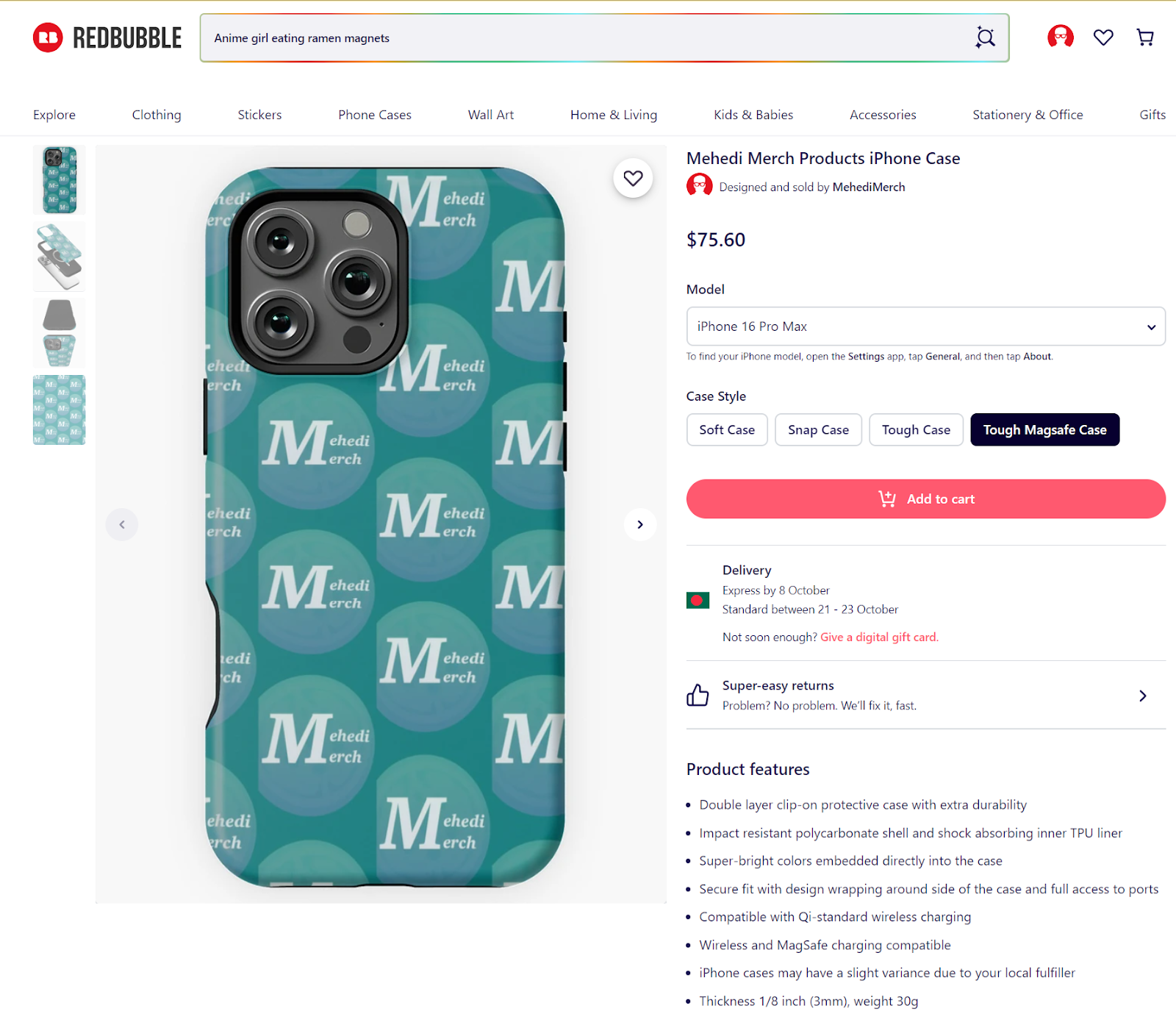
You can create various rigid, soft, and slim case options for almost every phone design. If you use a high-quality image for design and set it in the correct position, you can expect to deliver top-notch print quality to your client.
Redbubble blankets
You can also sell various types of blankets on Redbubble, which are generally found within the website’s “home and living” section. Like every other product on Redbubble, you can also customize the blankets depending on how your clients want them.
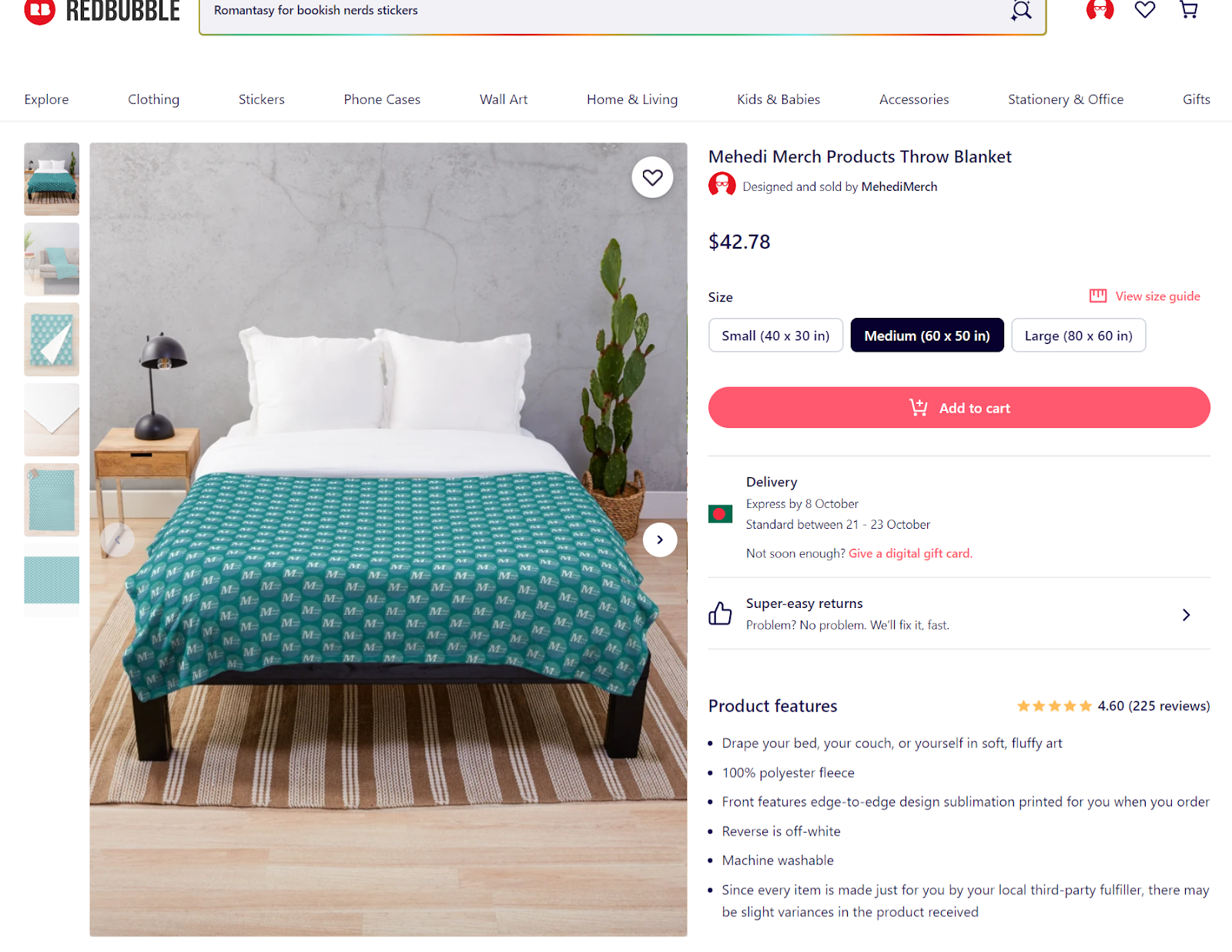
There is the option to upload various drawings, photos, and paintings and add them to blankets. Whether it’s a duvet cover, comforter, throw blanket, or blanket for your furry friend, you can offer a wide bedding collection.
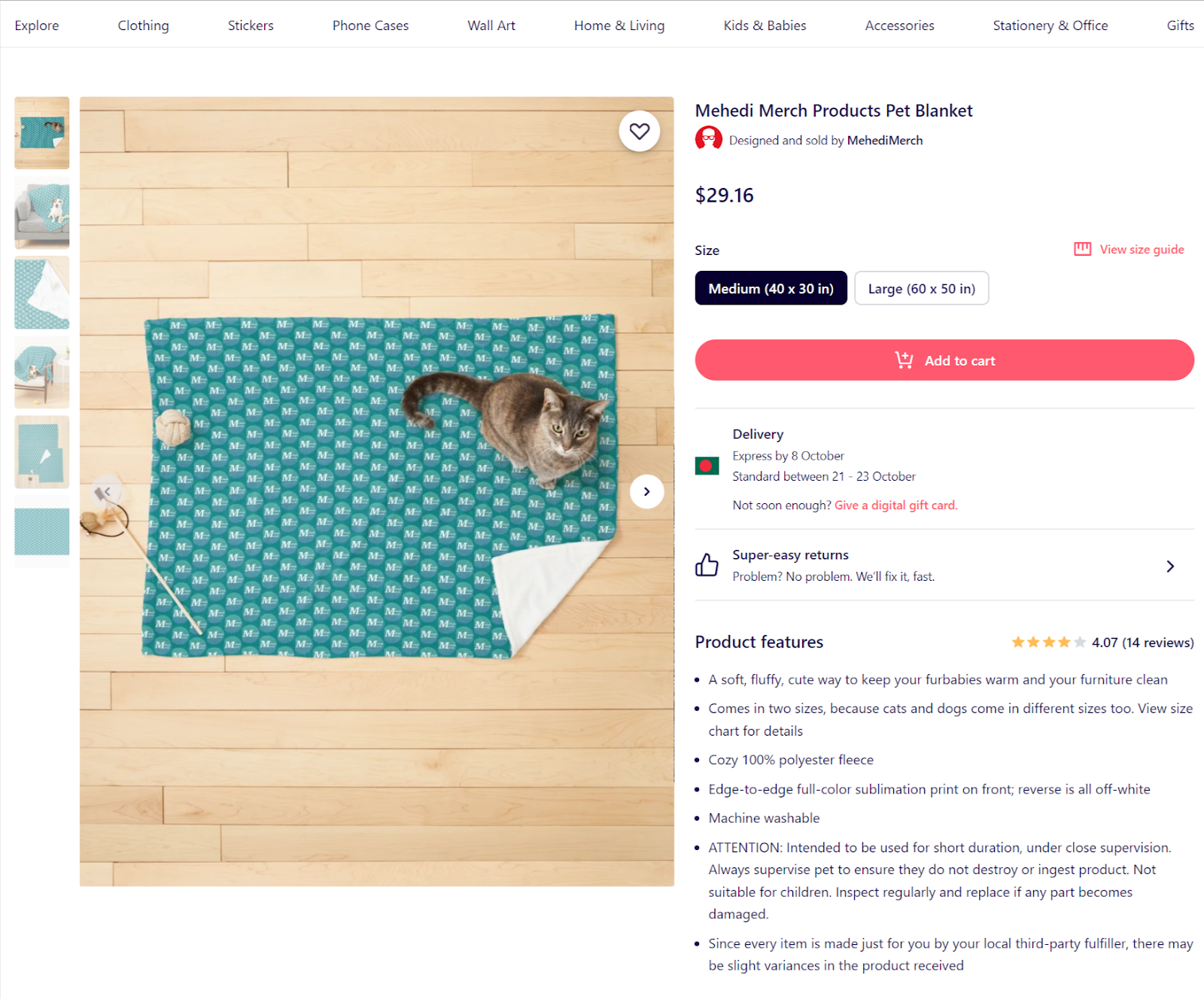
Redbubble backpacks
If you have an accessory line, you can also list it in Redbubble’s accessory section. A trending accessory item is a backpack.
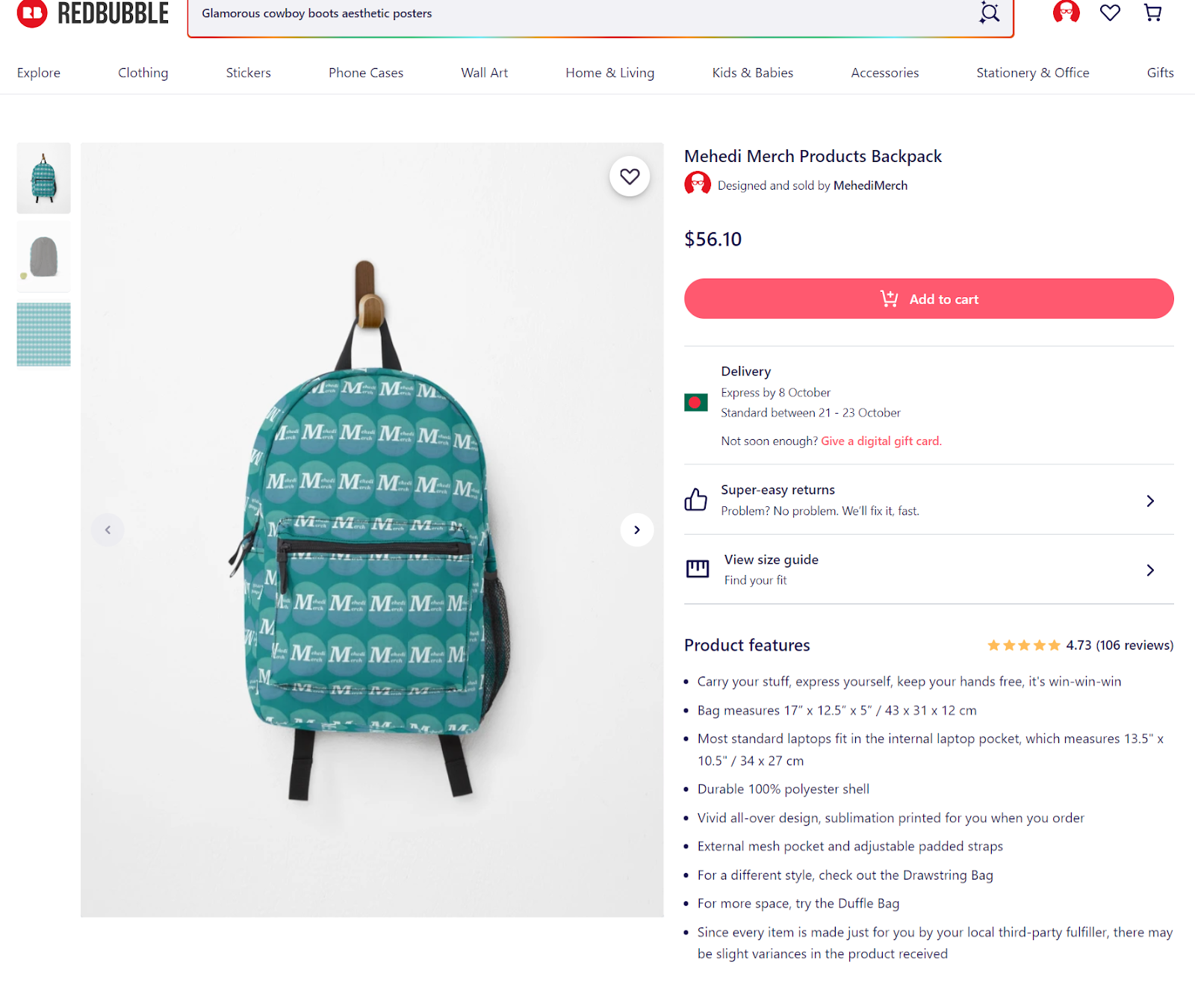
With their bigger storage, sturdy build, and eye-catching designs, backpacks are super convenient for customers to store their products. They also come with adjustable straps for added comfort.
Redbubble stickers
One of Redbubble's highly customizable products is stickers. Your client can have both matte, glossy, and transparent for your design. You can sell stickers as collections and bundles if you want, too. Stickers also have a dedicated tab on the website for buyers to browse.
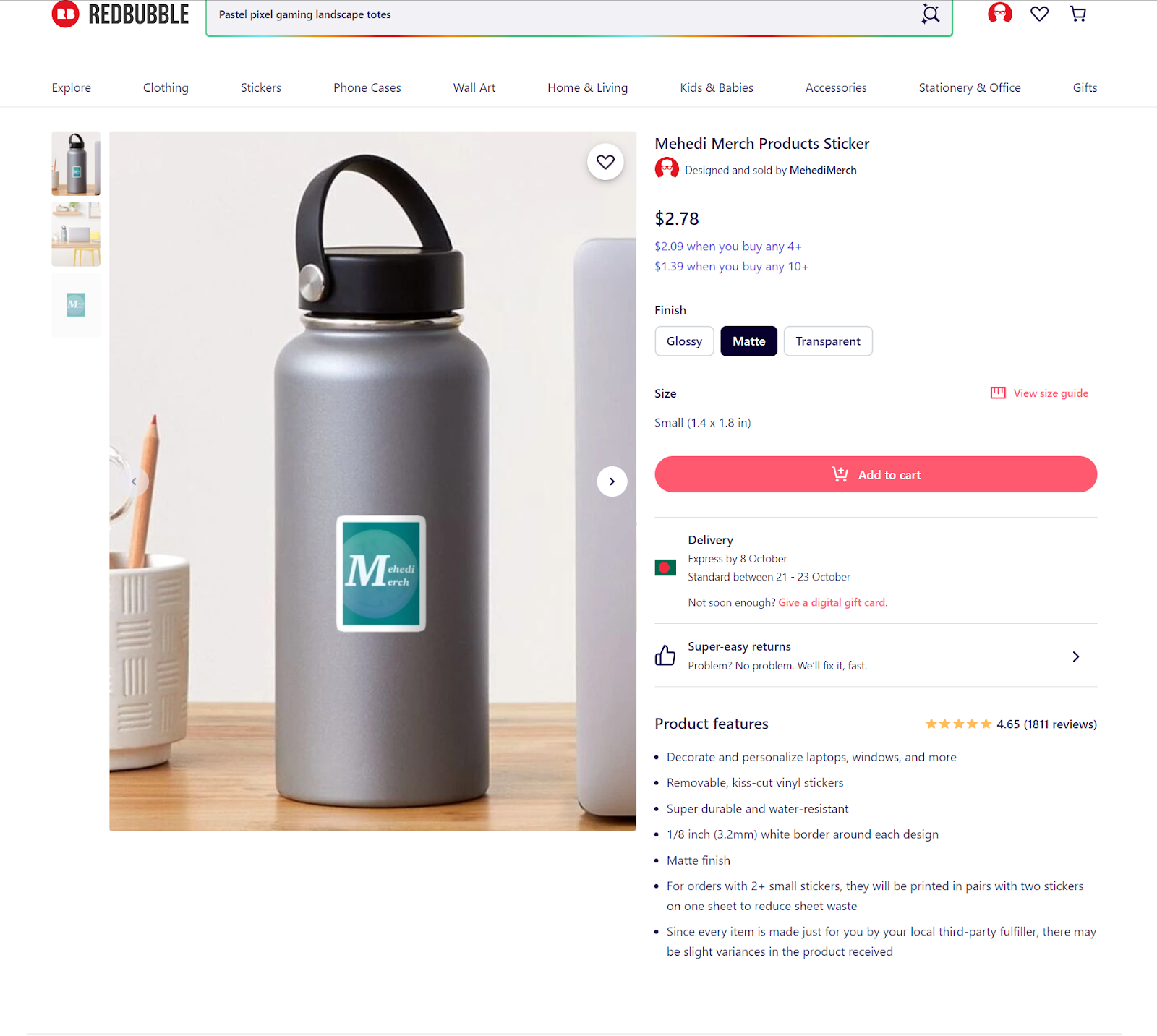
These are some of the first-line products. You can pretty much sell anything with your customized print on it, including masks, mousepads, magnets, hoodies, duffle bags, cotton tote bags, shower curtains, and many more.
While print quality mostly depends on image quality, Redbubble is also somewhat responsible for it. Since Redbubble outsources its print production work to 10 different third-party manufacturers, you can expect occasional variations in print quality.
Other Features of Redbubble
Redbubble's fan art program
Redbubble's Fan Art Partner Program allows artists to create officially licensed designs for popular brands. By partnering with well-known brands such as Back to the Future, Adventure Time, Star Trek, Rick and Morty, and many more, you can legally tap into a passionate fan base and monetize your creativity.
How the Fan Art Program works
- Choose a brand: Select a brand that aligns with your interests and artistic style.
- Review guidelines: Each brand has specific guidelines and requirements for designs. Familiarize yourself with these guidelines to ensure your artwork meets the brand's standards.
- Tag your artwork: Use the appropriate tags and keywords to indicate that your design is intended for the chosen brand.
- Submit for review: Once you've tagged your artwork, submit it for review by the brand's licensing team.
Thanks to Redbubble, you can create and sell officially licensed designs, avoiding legal issues associated with unauthorized fan art.
Redbubble affiliate program
You don’t always need art to earn through Redbubble. The platform offers an affiliate program for people interested in promoting artwork and earning commissions.
Redbubble's affiliate program is managed by Impact, a third-party affiliate marketing platform. Interested individuals can sign up through the "Join Via Impact" button on Redbubble's affiliate program page.
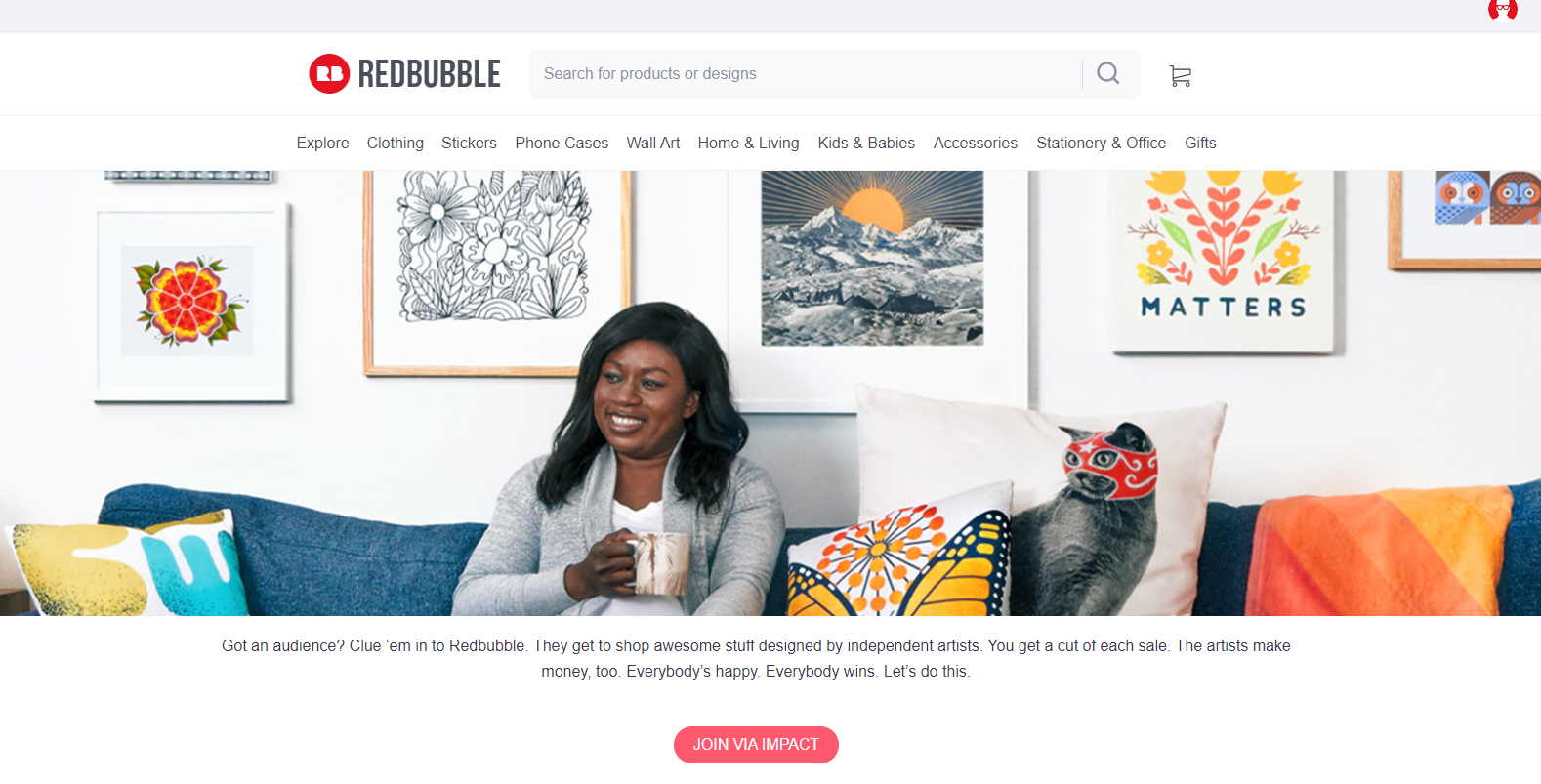
This program focuses on promoting designs already available on Redbubble. Affiliates can earn commissions by referring customers who purchase through their unique affiliate link. Affiliates can earn up to a 10% commission on sales generated through these links.
Redbubble offers a 30-day attribution window, meaning you can still earn a commission if someone clicks on your link today and purchases within 30 days.
Account analytics
Redbubble is a fantastic platform for selling a range of products, including phone cases, t-shirts, stickers, mugs, etc. It’s also user-friendly, and you can track the performance of your growing store and business.
How? Explore your account analytics.
You can check out your sales earnings and analytics by reviewing a chart of your sales trends over the last 30 days. For your convenience, you can add a filter of 7 days or 12 months as well. You’ll find a dashboard showing details about how the clients reached/found your store. For example, you can check if the clients are coming from the following sources:
- Organic visitors: These are visitors who were initially looking up something on Google and found and landed on your website through the results.
- Social media: People landing on your site through ads running on social media accounts (Facebook, Instagram, Pinterest, etc.)
- Redbubble: Traffic to your site through paid ads, affiliates, RB search, and marketing emails.
- Direct: Visitors directly type the URL of your Redbubble profile into a browser to reach your site, which indicates very strong branding.
- Others: People also visit your store from various other sources, sites, and links as they discover your brand online or offline.
The analytics features also let you see which of your products are best sellers. Moreover, you can track particular pieces that perform exceptionally well compared to others and use them as inspiration to launch similar products in the future.
Just when you thought it couldn’t get any more detailed, you get an entire guide listing your most popular/best-selling products and the quantity of each item sold within a specific time. You’ll get new, refreshed data at 2 am UTC every day to get the most accurate analytics.
How Much Does It Cost to Sell on Redbubble?
Redbubble offers a free platform for artists to sell their designs. You can list your products for free. However, there are fees involved when a product is sold.
Commission fees and profit margins
- Base fees: Redbubble charges a base fee for each product sold, which varies depending on the item, covering manufacturing and shipping costs.
- Profit margins: As a seller, you set your profit margin by choosing a percentage markup for each product. This markup is added to the base fee to determine the final selling price. Redbubble recommends a 20% markup, but you can adjust it as needed.
Example: If the base cost of a t-shirt is $20 and you set a 100% markup, the final selling price will be $40, and your profit will be $20. You can adjust the markup percentage for each product individually to optimize your earnings.
Example: Large framed art prints have a base price of US$125.00 in the US. If you set a 20% markup for them, 20% of the $125 base price means you get an artist margin of $25.00. The $125 base price + $25 artist margin makes for a $150 retail price (before tax).
Redbubble's pricing flexibility is a significant advantage compared to some other print-on-demand platforms that may have fixed markup rates. This allows you to tailor your pricing strategy to different products and target audiences.
Note: This was more beneficial to sellers until they introduced the new account tier system. We’ll talk more about that.
Redbubble account costs: Is it worth it?
Redbubble's recent fee changes have sparked discussions among artists. This section aims to clarify the platform's pricing structure, including base prices, artist markups, and the new account fee structure.
Before the new pricing update, you owned all of the markup. However, that has changed because of the new system.
Redbubble has introduced a tiered system where artists pay a monthly fee based on their earnings. The cost increases as your monthly sales grow, potentially impacting your profits. This new structure has faced criticism for its lack of transparency and potential to discourage smaller artists.
Account tiers
- Redbubble Standard: The starting tier for new artists, includes a monthly account fee.
- Redbubble Premium: Offers benefits like fee exemption, increased marketing, and priority support.
- Redbubble Pro: The final tier is for top-selling artists with exclusive features and dedicated support. The Redbubble Pro tier is for artists in the top-seller program.
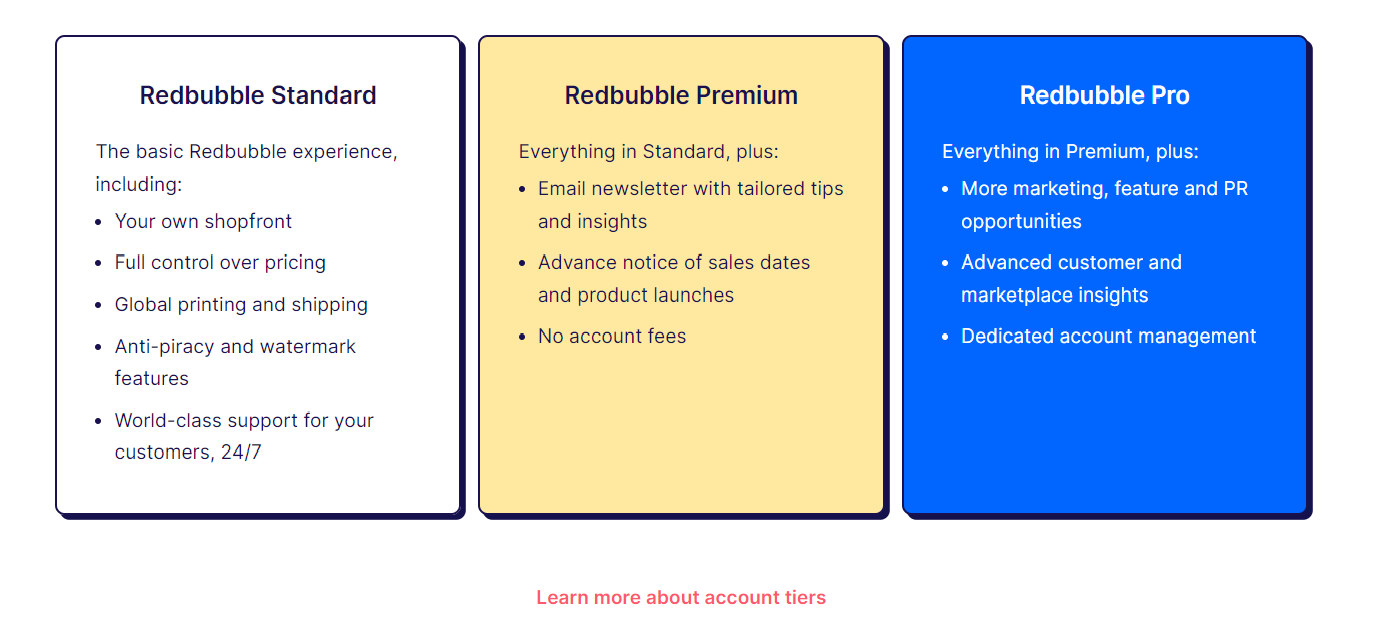
For artists considering Redbubble, it's essential to carefully consider the impact of fees on your earnings and evaluate whether the platform's benefits align with your goals—Redbubble takes almost 25-50% of your profit margin.
| Earnings bracket | Monthly fee |
|---|---|
| 0.00 to 1.99 | 0.00 |
| 2.00 to 2.99 | 1.30 |
| 3.00 to 3.99 | 1.90 |
| 4.00 to 4.99 | 2.45 |
| 10.00 to 10.99 | 5.80 |
| 20.00 to 20.99 | 12.20 |
| 30.00 to 30.99 | 20.70 |
| 40.00 to 40.99 | 27.20 |
| 90.00 to 94.99 | 46.50 |
| 200.00 to 224.99 | 71.00 |
| 500.00 or more | 97.00 |
Is Redbubble Right for You?
Here are some key reasons you should use Redbubble. Redbubble can be a particularly appealing platform for artists due to its:
- Product variety: You can offer your designs on a wide range of products, expanding your potential customer base.
- No inventory management: Redbubble handles the production and shipping, eliminating the need for you to manage inventory. This essentially removes any risk you might have.
- Minimal customer interaction: Redbubble handles most customer interactions as a print-on-demand platform, reducing the need for direct communication.
- Remote work: You can operate your Redbubble business entirely from home, avoiding the need for face-to-face interactions.
- Indirect feedback: While you may receive customer feedback and messages, you can choose how much you want to engage in these interactions. This offers a degree of control over your social exposure.
If these interest you, then yes, Redbubble seems like a good fit for you.
The Finer Details of Redbubble's Print-on-Demand Model
Redbubble's POD model allows artists to sell their designs without the hassle of inventory management or fulfillment. But you might be curious about the quality of the products, customer support, how you’ll receive your payment, etc.
Here's a breakdown of all of those:
Product quality
Redbubble primarily uses direct-to-garment (DTG) printing for its products. While DTG offers a versatile printing method, it may not always match the quality standards of some competitors' screen printing.
The product quality of Redbubble has received mixed reviews from customers. While many praise the quality of their products, especially considering the industry average for DTG printing, some have expressed concerns about shipping delays and occasional non-receipt of orders.
Shipping and delivery
Redbubble uses a global network of shipping carriers, including UPS, FedEx, DHL, and local postal services, to ensure timely and efficient delivery of orders to customers worldwide.
Payment and transactions
Redbubble prioritizes the security of your personal information and financial transactions. The platform employs security measures to protect your data and ensure a safe shopping experience.
Additionally, Redbubble ensures:
- Encrypted connections: Redbubble uses encrypted connections to safeguard your payment information during the checkout process.
- Secure data processing: Payments are processed through secure data processors, minimizing the risk of unauthorized access.
- Data storage security: Redbubble implements technical security measures to protect your personal data stored in its databases.
The commitment to transparency regarding Redbubble's security measures helps build customer trust. By understanding the steps taken to protect their information, customers can feel confident when making purchases, and sellers can feel safe selling on the platform.
Legal compliance
Redbubble takes intellectual property rights seriously and is committed to complying with copyright and trademark laws. The platform has policies in place to protect artists and ensure that your work is not infringed upon.
If you believe your copyright or trademark is being violated on Redbubble, you have the right to file a formal complaint. Redbubble's copyright and trademark policy outlines the steps to report infringement.
Intellectual property rights (IPR) encompass a range of legal protections that safeguard the creative aspects of an artist's work. With IPR, you can maintain control over your creations and benefit commercially from your artistic efforts.
Redbubble actively works to prevent copyright and trademark infringement on its platform. This includes reviewing uploaded designs and taking action against infringing content.
By respecting intellectual property rights, Redbubble helps to create a fair and equitable marketplace for artists.
Customer support
Redbubble offers a help center and contact options for customers seeking assistance or information. While many users report satisfactory experiences with Redbubble's customer support, there are also reviews of delayed responses or lack of communication.
The Redbubble help center provides a good collection of resources for customers to find answers to common questions. Many customers have reported positive experiences with Redbubble's customer support agents, who are generally responsive and helpful.
However, some customers have complained about lengthy response times to their inquiries or concerns. In certain cases, customers have reported difficulties reaching out to customer support or receiving satisfactory resolutions to their issues.
A Step-by-Step Guide to Selling With Redbubble
Redbubble simplifies the process of selling your designs online. Here's a breakdown of the key steps involved:
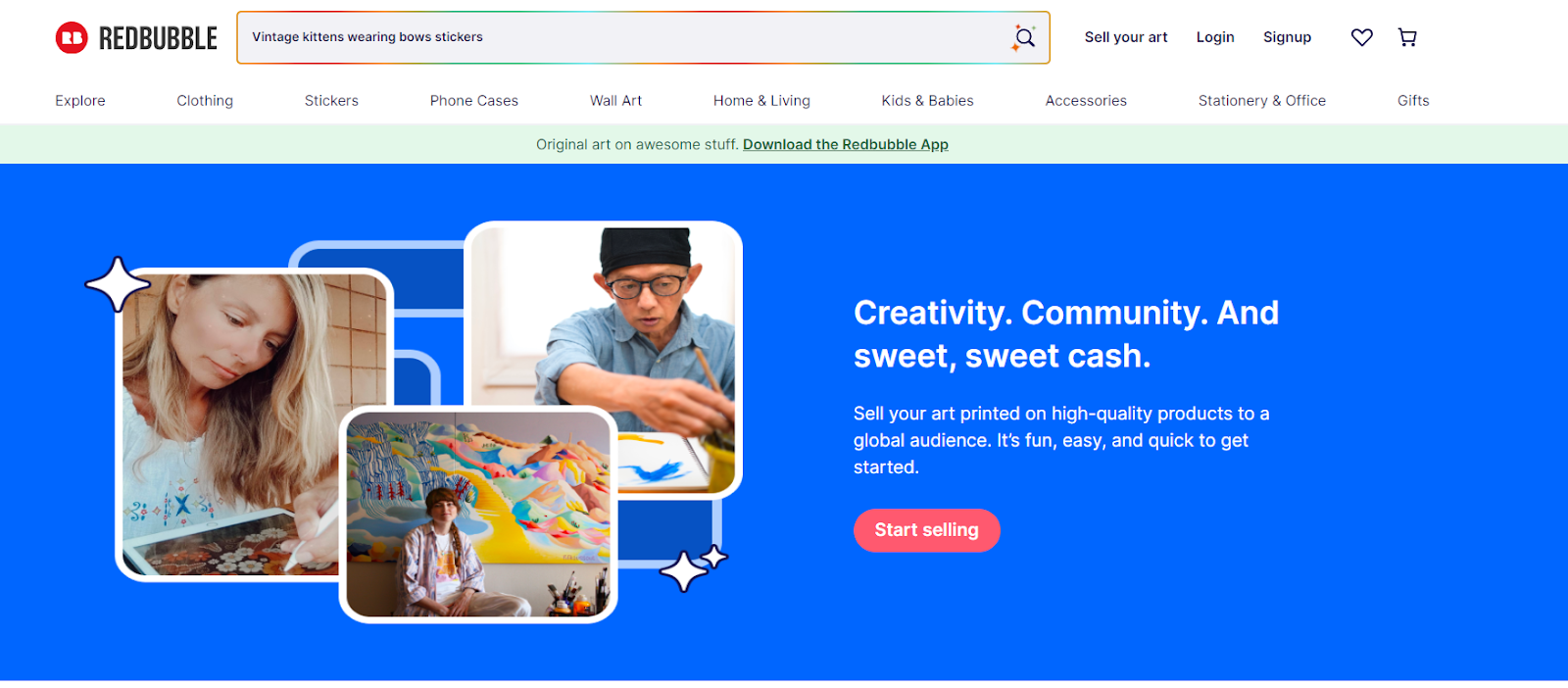
1. Creating your Redbubble seller account
To create a free seller account on Redbubble, you must visit their website and click the “Start selling” button. You must choose to sign up as a seller to create an artist account.
After that, you’ll need to provide your email address, give it a unique password, and verify your account.
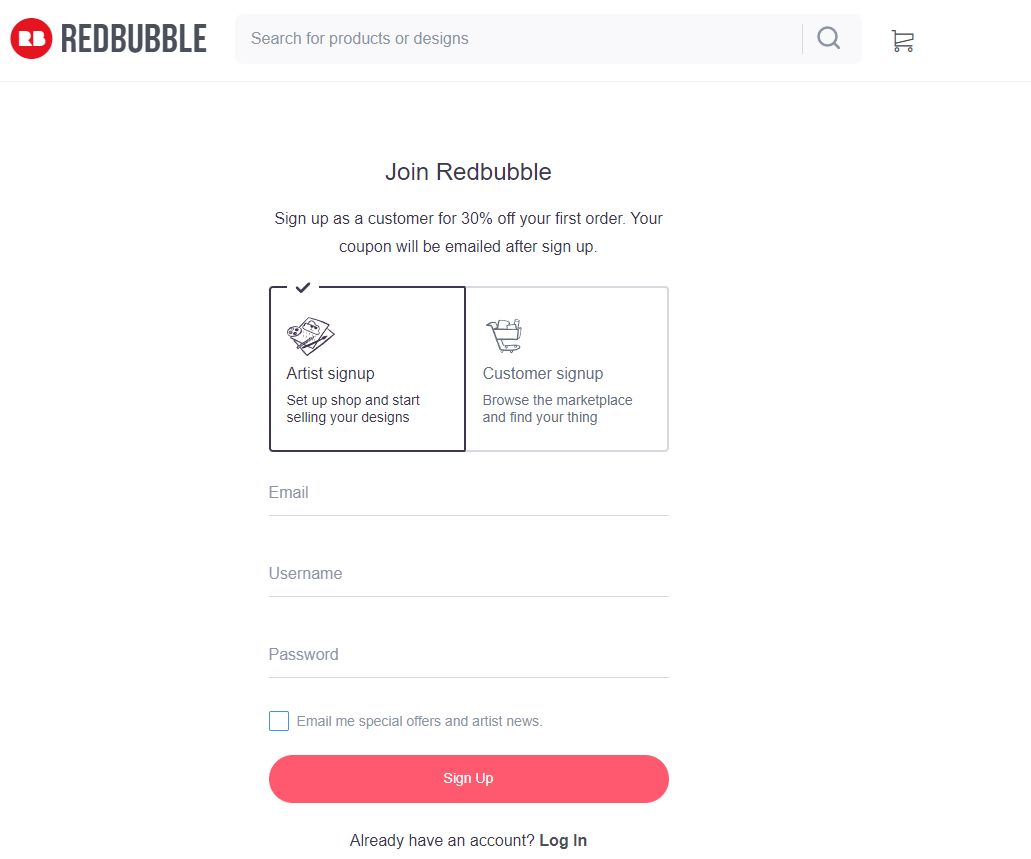
2. Setting up your storefront
Personalize your profile: To showcase your artistic style, you can add a profile photo, cover photo, and interesting artist bio. You can also include links to your social media accounts to reach potential customers.
Choose your products: Select the categories and subcategories where you want to offer your designs. Redbubble provides a wide range of items in categories based on audience and genre. Stickers, phone covers, home decor, and clothing are popular choices.
Set your prices: Redbubble gives you a range of price options to help you manage your profit margins. You can choose markups for certain products, establish a percentage markup applied to all your items, or let Redbubble price your designs automatically based on its suggestions. You can change the 20% markup that they automatically apply.
3. Uploading and optimizing your designs
You can upload your artwork from quite a few places. After selecting your profile picture in the upper right corner, all you have to do is click the red "Sell Your Art" button. You may also use the "Add New Work" button located in the upper right corner of the Dashboard.
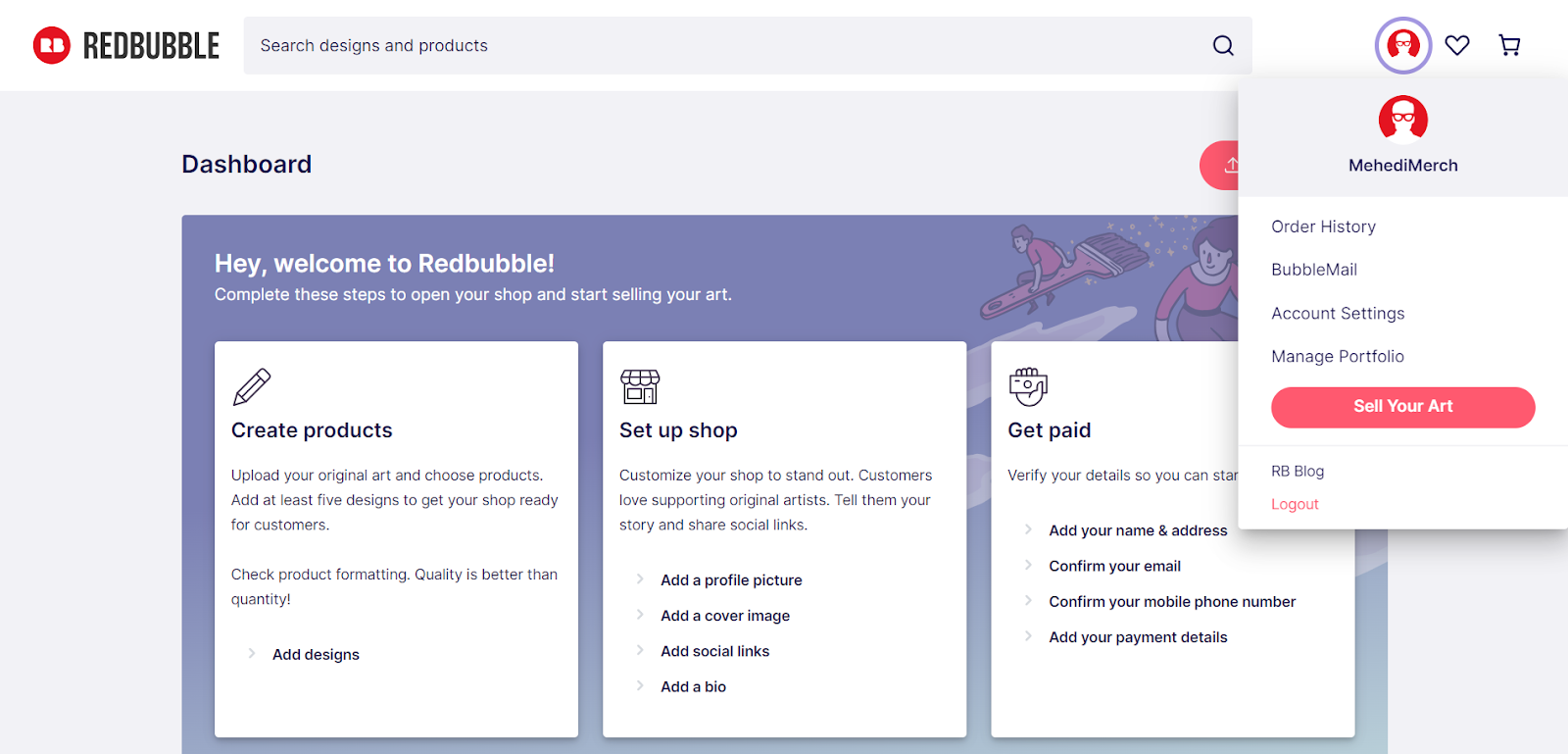
After clicking, you will be given two options: "Upload new work" or "Copy an existing work." If you want the product placements and options to be the same, you would replicate an existing work.
For instance, if you are submitting several 16x20 paintings, you should duplicate an existing piece, as you would want the ratio to be the same for each one. Uploading several pieces of art that are similar in size or style saves you a ton of time.
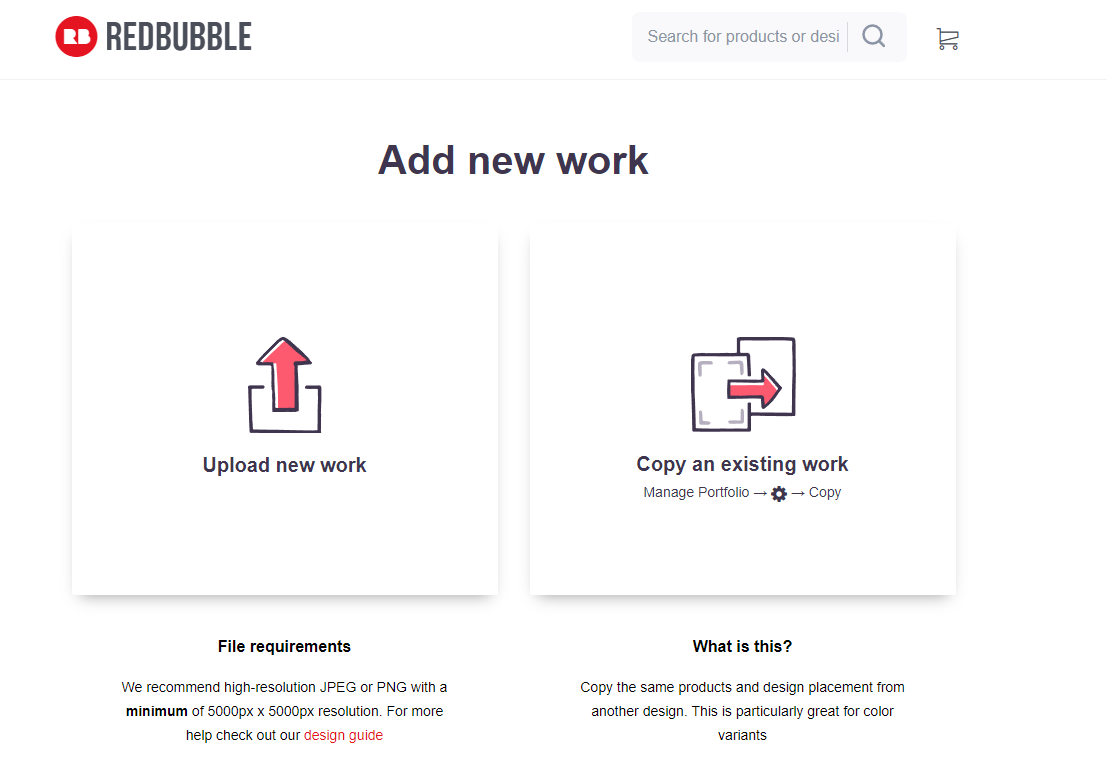
Since this is your first time, we'll be going with "Upload new work."
Upon selecting "Upload new work," a popup will appear, asking you to choose a file from your computer. Once the file has been picked and uploaded, you can add a title, tags, and description and choose which products you want the artwork to be sold on.
To change the artwork alignment, size, and other elements of each product, click the "Edit" button beneath the product you want to work on.
Using the options at the bottom of this page, you may choose the medium of your artwork, add it to a collection, control who can see it, and indicate whether or not it contains mature content.
The next step before selecting "Save Work" is to tick the small box stating that you are allowed to sell the artwork.
4. Promotion and marketing
As artists and sellers on Redbubble, having a strong promotional strategy comes right after your sales. They’re also correlated, so you must have an effective promotional strategy to ensure your products receive proper visibility. Redbubble is your best friend here, as you can easily get some initial impressions with the platform.
Consider building your brand’s off-site marketing with content creation and email campaigns on external websites to bring customers to your Redbubble shop. There’s also a dedicated section for featured artists, which allows them to list products to reach the maximum potential clients.
Besides hunting for clients, you also need to ensure that your shop design effectively satisfies the Redbubble algorithm. To do that, use the right tags, format designs appropriately, keep uploading inventory with trendy products, and, most importantly, have a complete profile.
You can use Redbubble's built-in audience to reach potential customers. You don’t need to bring customers to your products. Redbubble will do that for you with its marketplace.
You can also share your Redbubble shop and merchandise on social media and other platforms to bring external customers to your products. Being active on social media helps you get exposure by uploading content. Social media platforms like Pinterest are a great option for getting visibility through sharing and word-of-mouth marketing.
How Do I Get Paid by Redbubble?
Redbubble offers multiple payment options for artists. The specific method available to you will depend on your location.
Payment Methods
- PayPal: For artists outside of Australia, the United States, and the United Kingdom, PayPal is the primary payment method.
- Bank transfer: If you live in Australia, the United States, or the United Kingdom, you can also opt for a bank transfer.
Payments are processed on the 15th of each month. If a product you've sold hasn't shipped yet, your payment will be processed on the 15th of the following month. Make sure your PayPal account is verified to avoid manual claim processes.
Redbubble has a $20 minimum payment threshold. This means you must earn at least $20 before receiving a payment. Because of this, artists just starting might need a few months before they can receive their first payment from Redbubble. The $20 payment threshold can impact your earnings frequency. If you consistently earn less than $20 per month, it may take several months to receive a payment.
You can access and modify your payment settings by visiting your Redbubble Dashboard and selecting "Edit Payment Details" under the "Account Settings" section.
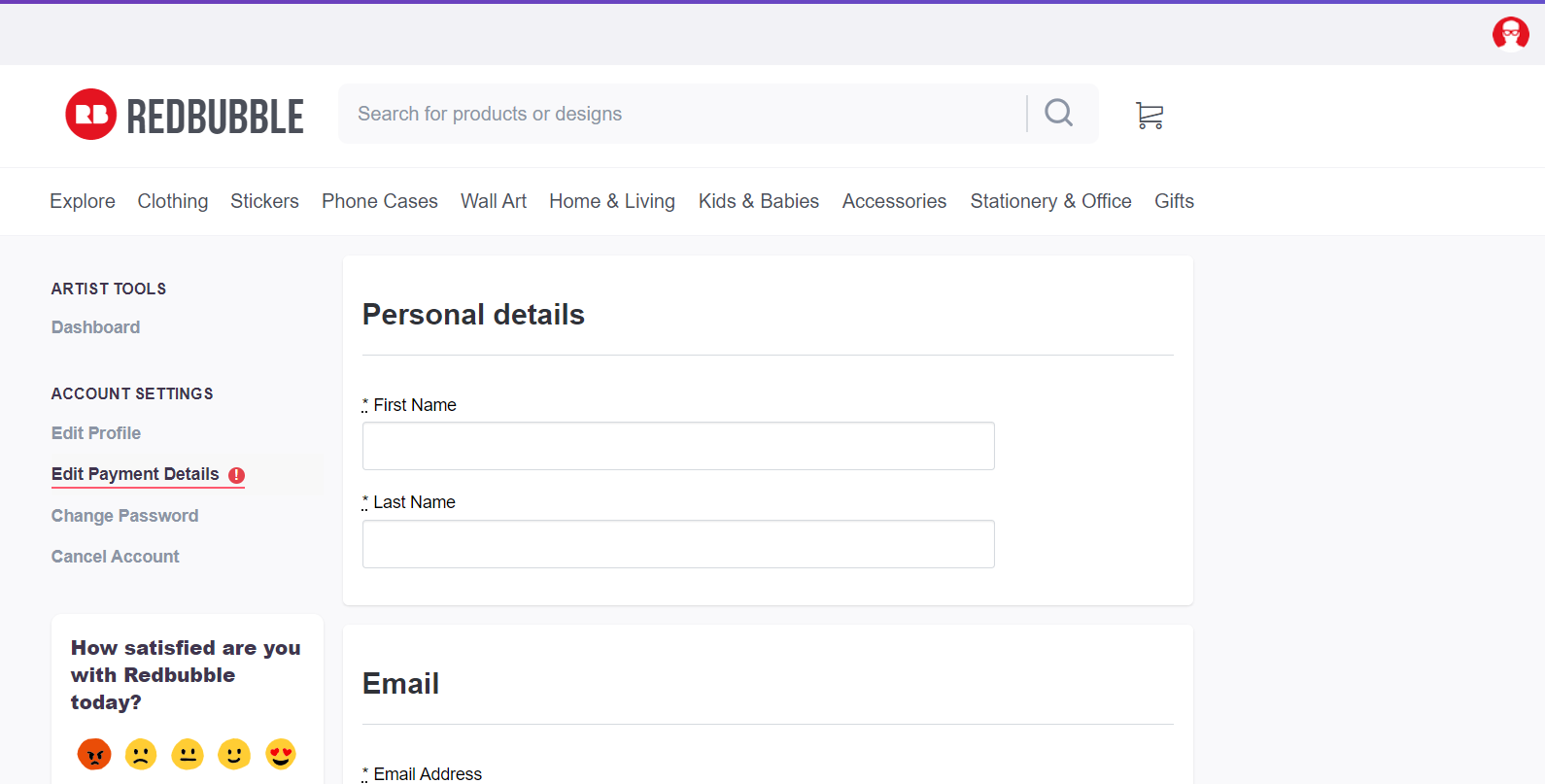
Redbubble Pros and Cons
Benefits of Redbubble
While Redbubble has its drawbacks, there are several notable benefits to using the platform:
- Free storefront: Redbubble provides a hosted storefront, eliminating the need for you to manage your own website. This can save you significant monthly costs, typically around $20 or more.
- Simplified product creation: Uploading a single JPG file allows you to easily offer your artwork on a wide range of products with minimal adjustments.
- Hands-off operations: Redbubble handles payment processing, production, quality control, shipping, and customer service, freeing you to focus on creating art.
- Complete control over pricing: You have full control over your profit margins, allowing you to set prices that align with your business goals.
These advantages make Redbubble an attractive option for artists seeking a convenient and cost-effective platform to sell their designs.
Redbubble drawbacks
- Limited control over customer relationships: Redbubble retains customer information, making it difficult for artists to build direct relationships and market future products. This can be especially detrimental because Redbubble can and will promote other sellers' products to customers who joined the site because of your art.
- Branding and product quality: Redbubble's branding and potential quality control issues can dilute your brand identity and impact customer satisfaction.
- Profit margins: Redbubble's fees, especially the newly updated fees for smaller sellers, can notably reduce your earnings. Depending on your sales, they can take anywhere from 25-50% of your profits.
- High competition: The competitive nature of Redbubble's marketplace makes it challenging to stand out and attract customers.
- Unclear tier progression: The criteria for advancing to Premium and Pro tiers are not transparent, leading to dissatisfaction among artists and questions about fairness.
- Unwarranted suspensions: Sellers may find their accounts suspended without a clear explanation, leading to financial losses and disruption.
- Appeal process: Appealing a suspension can be cumbersome and time-consuming, especially given Redbubble's reliance on a help center and chatbot for customer support.
Alternatives to Redbubble
If you don’t feel like using Redbubble, here are some top POD alternatives.
Sellfy
Sellfy is considered the first pick for a Redbubble alternative, considering its overall features. With this POD platform, you have a lot more control over your storefront and how you sell and market your POD products.
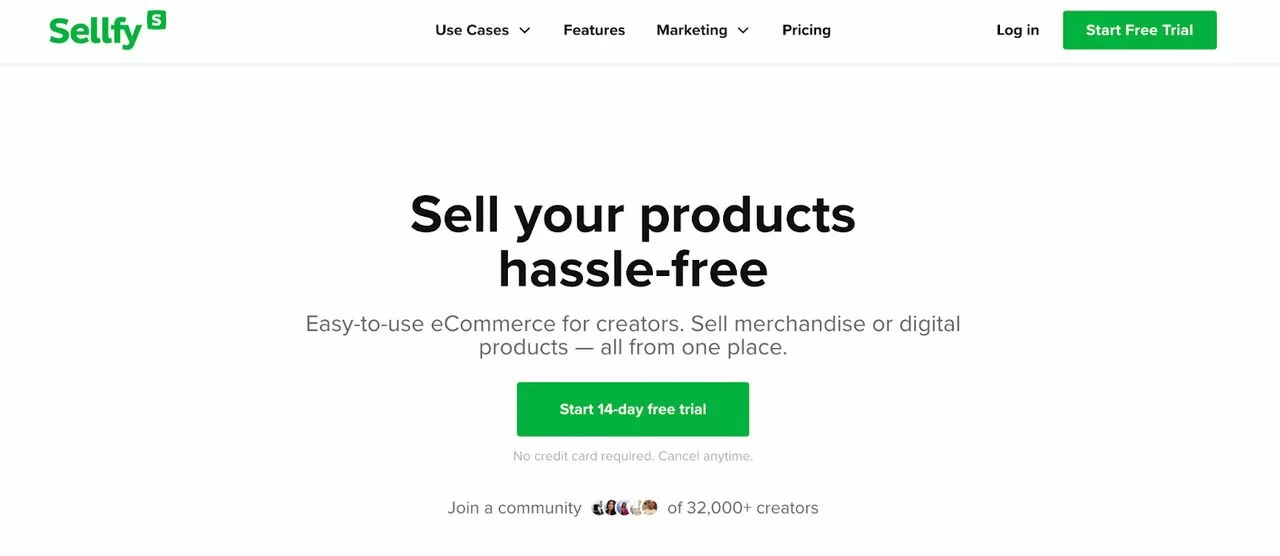
The only difference is that Sellfy is not a marketplace like Redbubble. Rather, it is an ecommerce platform created for creators and artists, where they can market and sell both physical and online products.
However, Sellfy doesn’t rely on plugins for facilitating sales like other print-on-demand platforms. Instead, it does so directly on the platform with its built-in POD feature.
Once you’ve signed up and created your storefront, you can add your product designs, including various merchandise, including custom hats, phone cases, t-shirts, home decor, etc.
Also, Sellfy encourages environmentally friendly lines, offering eco-friendly, sustainable product lines and merch. Moreover, to support this cause, they have CPSIA-compliant POD products and water-based inks for printing to reduce toxic waste in the environment. This approach is also taken to ensure maximum safety for children’s clothing/fabric.
If you’re interested in a subscription, they charge $22/month, but you can get discounts on longer/annual subscriptions. You can also enjoy a 14-day free trial and a 30-day money-back policy.
Gelato
Founded in 2012, Gelato is a software startup based in Oslo, Norway. Gelato has rapidly gained popularity as a leading print-on-demand platform, offering a range of features and benefits for artists and entrepreneurs.
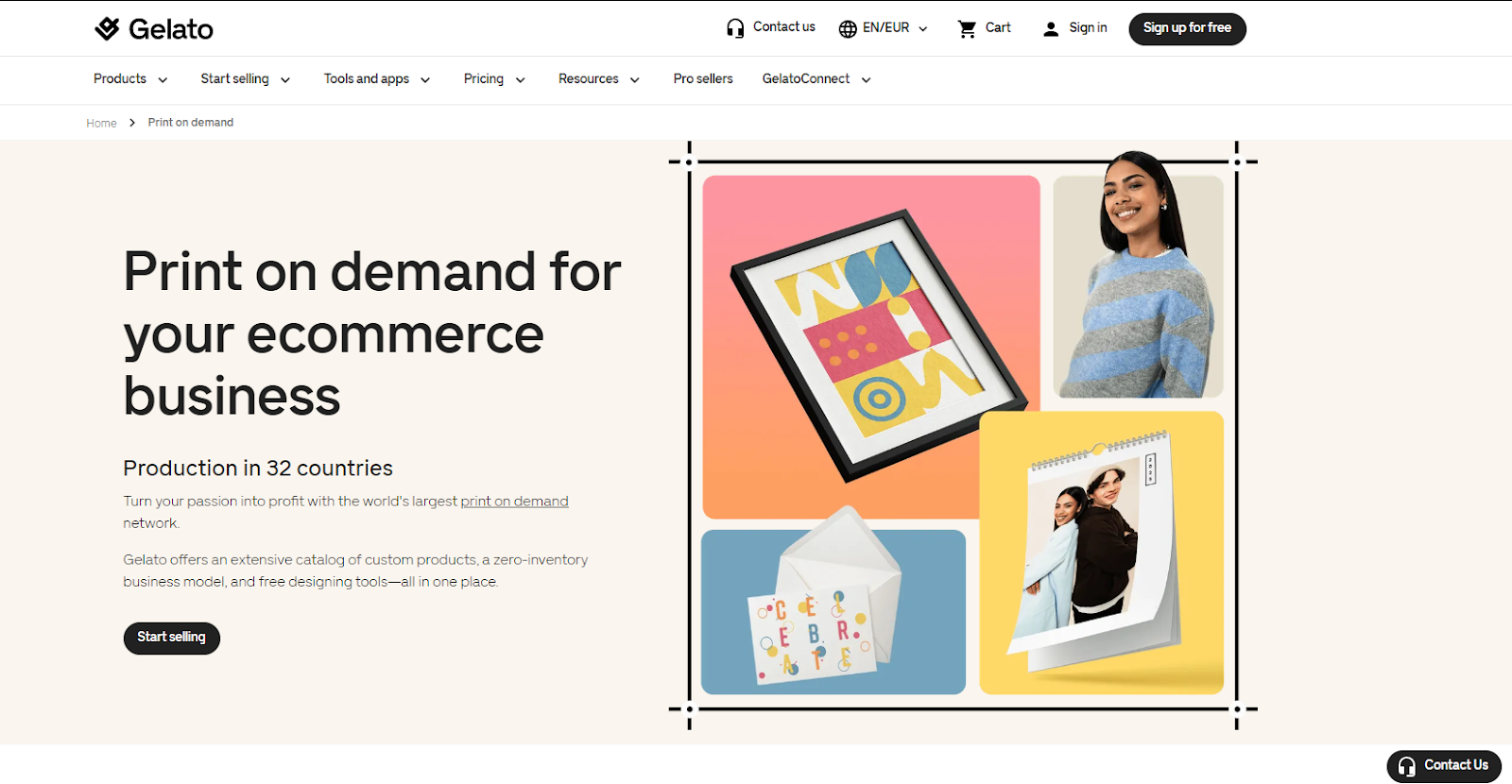
With its free plan for up to two stores and a vast selection of products, Gelato presents a compelling alternative to other platforms.
You can choose from over 90 product categories to find the perfect fit for your artwork. With real-time tracking, you can also stay informed about the status of your orders. Gelato has an extensive network of production facilities in 32 countries.
Gelato claims that their customer service is available 24/7. However, this is actually a support chatbot rather than human help. Shipping costs are not included in the product pricing, so it's essential to factor them into your pricing strategy. Gelato also doesn’t let you collect customer information.
Zazzle
With 30 million customers, Zazzle is considered the second-most-famous POD marketplace worldwide. Although it doesn’t have the heavy traffic of Redbubble, it has an extensive product range and an expanded client base.
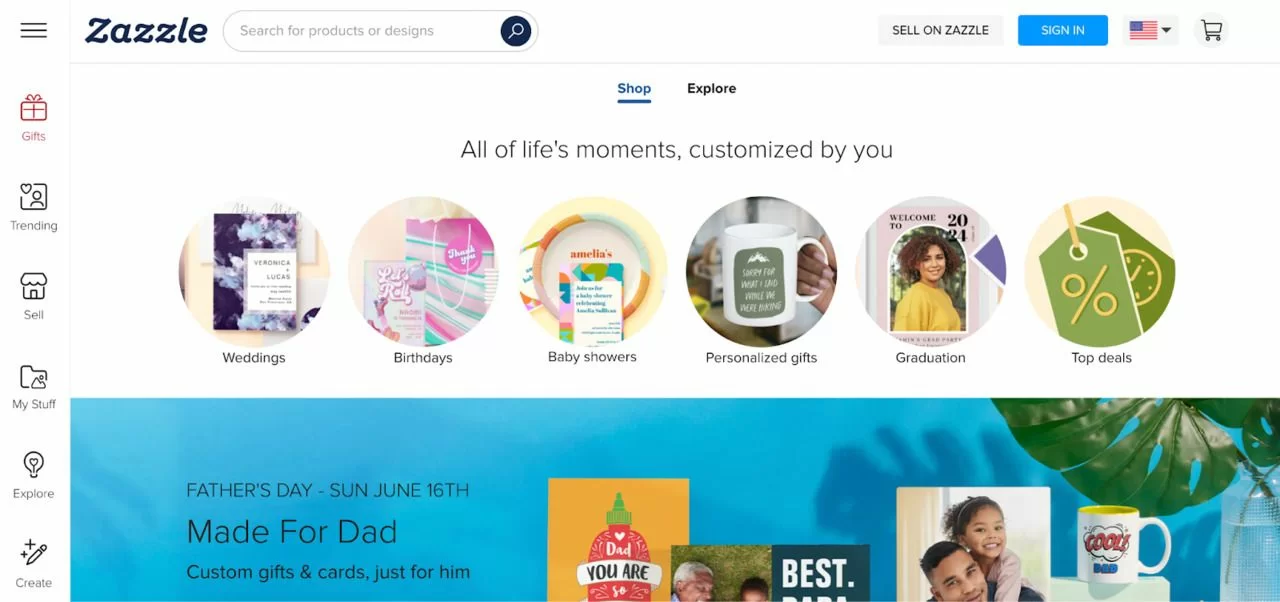
So, you can expect to get your desired visibility and reach without spending a hefty amount on marketing. The best part is that Zazzle has a built-in option for all your marketing requirements, from social media and SEO to referrals and email marketing.
It’s super simple to get started on Zazzle. Similar to other print-on-demand platforms, you need to set up your customized storefront and add designs to your products. Whether you’re selling mugs, stickers, t-shirts, or wall decor, you can add your designs to them.
Once that’s done, it’s time to set pricing. As a creator, you have the full freedom to set your royalty rate, which is later added to the base cost. Zazzle recommends keeping royalty rates between 10%-15% to set a realistic price range, but it’s really up to you and the perceived artistic value of your product.
Zazzle also takes care of printing, customer care, and shipping. As soon as you sell a product, you'll immediately receive your payment. There’s another feature that allows you to make some extra money—Zazzle LIVE. On Zazzle LIVE, you can earn money at an hourly rate by providing design services.
Printful
Founded in 2013 by Latvian entrepreneur Lauris Liberts, Printful has rapidly evolved from a small-scale poster business to a global leader in the print-on-demand industry. It allows individuals and businesses to create and sell customized merchandise. Using Printful's intuitive drag-and-drop tool, you can easily create unique designs.
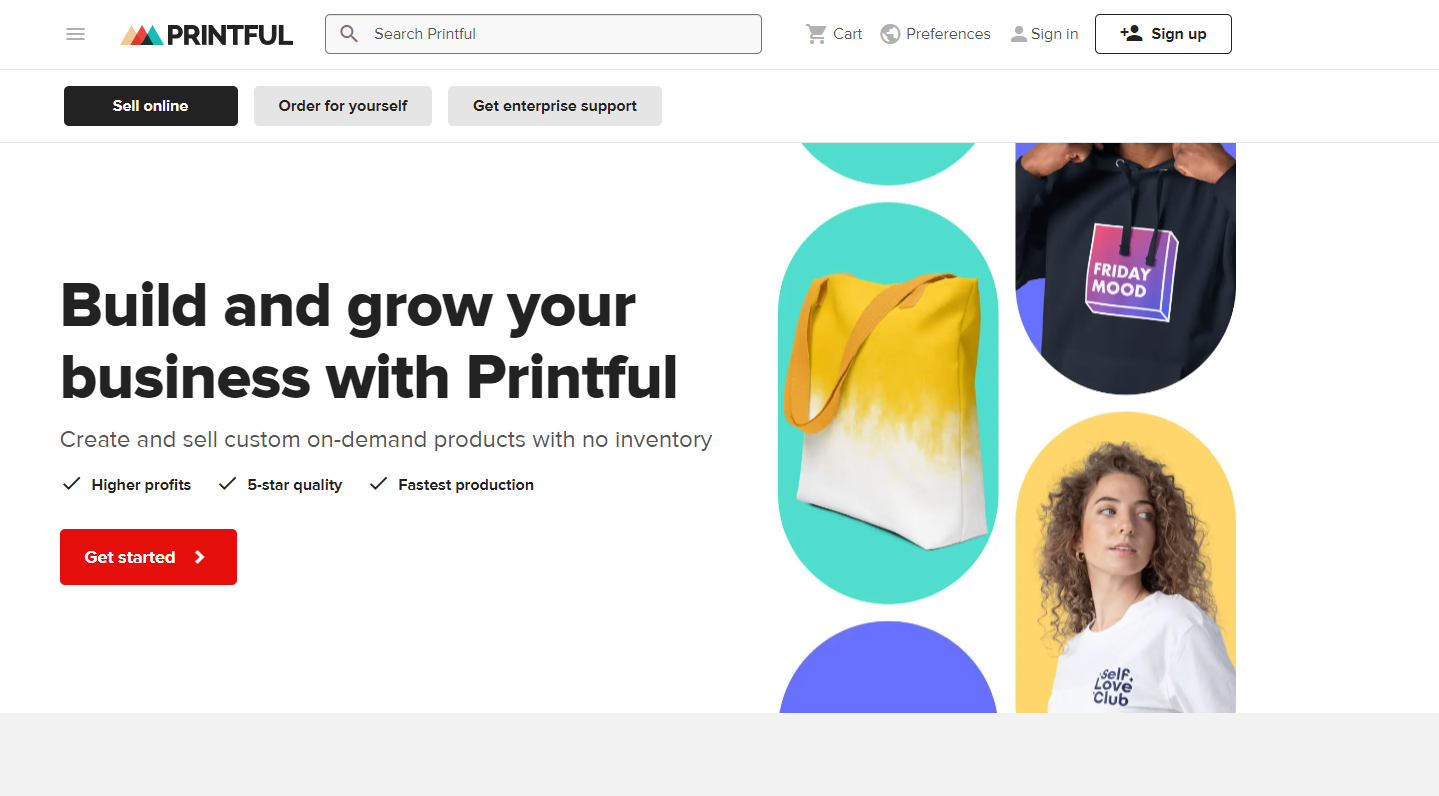
Printful now operates 15 printing and shipping facilities across four continents, serving customers worldwide. The company has grown to employ over 1,700 people. Printful has successfully completed over 86 million deliveries, demonstrating its operational efficiency and customer satisfaction.
Printful has achieved significant growth, attracting over one million registered users and securing a $1 billion valuation. This success is a testament to the platform's appeal and the increasing demand for print-on-demand services.
With its extensive product range of 340+ products, user-friendly platform, and global reach, Printful has become a popular choice for artists looking to explore the world of online retail.
Printify
Founded in Latvia in 2015 by Artis Kehris, James Berdigans, and Gatis Dukurs, Printify has emerged as another major player in the print-on-demand industry.
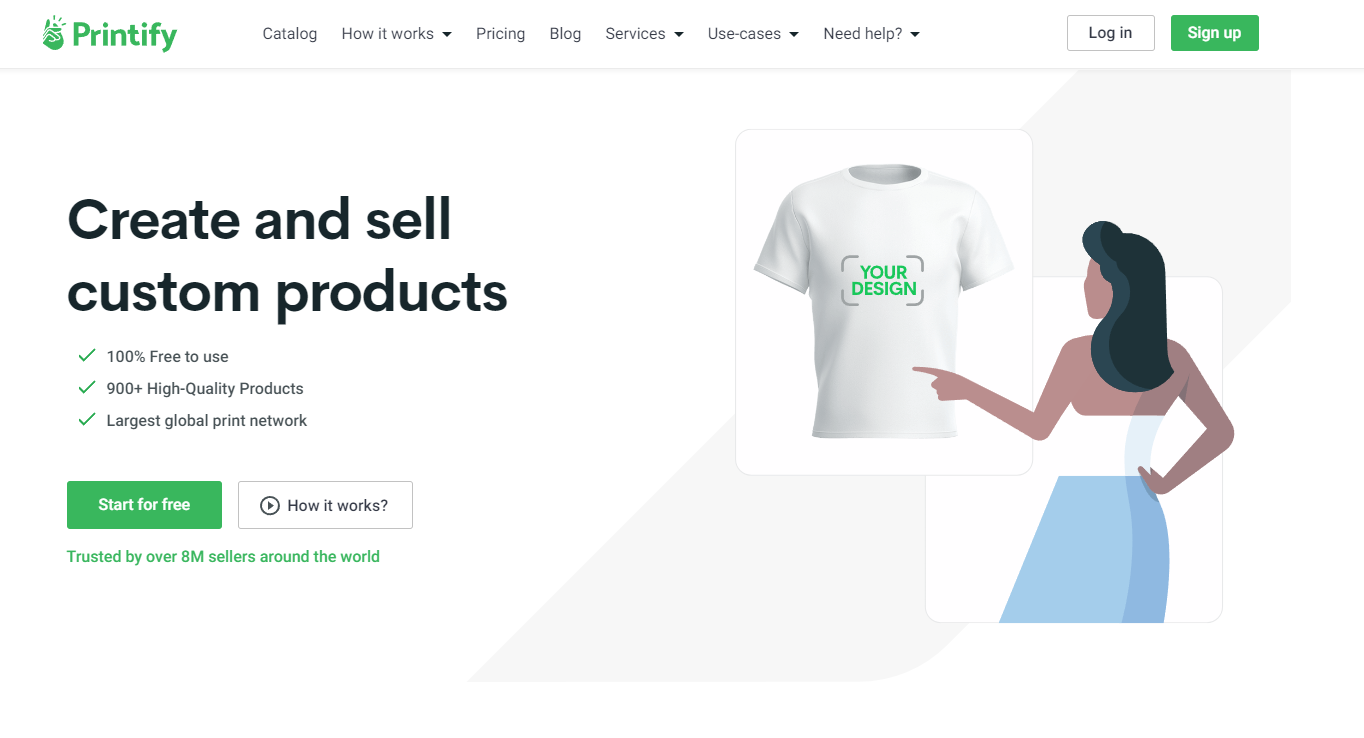
Printify has achieved a significant valuation of $300 million, reflecting its rapid growth and success. The company has generated over $500 million in sales, demonstrating its strong market position. Printify boasts an impressive user base of over 8 million, indicating its popularity among artists, entrepreneurs, and businesses.
Unlike the other POD platforms on this list, Printify operates as an intermediary between print providers and merchants. This model allows Printify to offer a wider range of products and potentially more competitive pricing by leveraging multiple suppliers.
Printify maintains relationships with over 110 printing facilities across 12 countries worldwide. This extensive network enables Printify to offer global shipping and production capabilities.
New to Ecommerce? Find Advice and Education on Whop
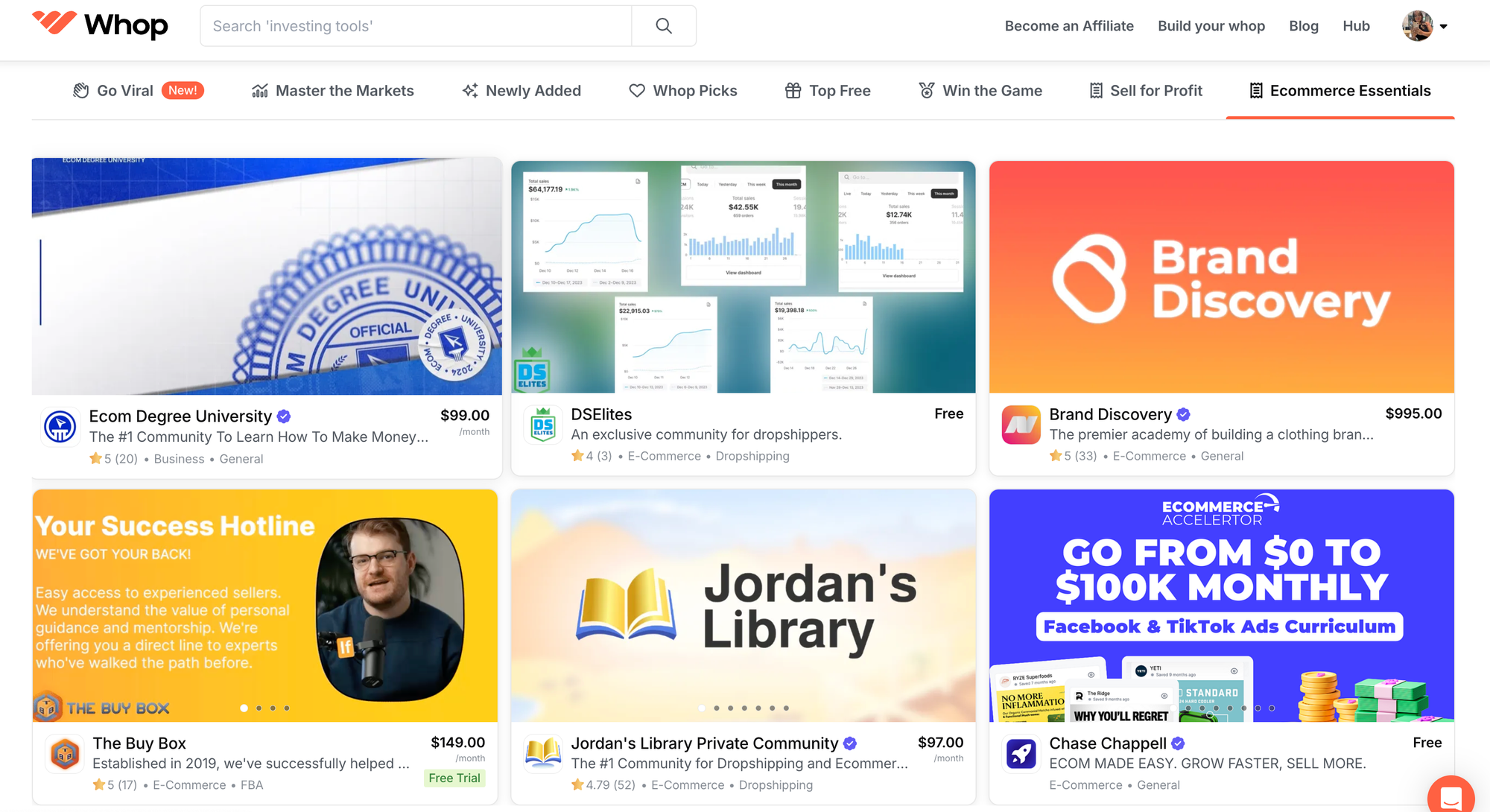
Starting your own print-on-demand store can be overwhelming, with countless factors to consider, from market research to social media presence.
Whop offers valuable resources for navigating the complexities of ecommerce. Whether you're a seasoned entrepreneur or just starting out, you'll find insights and advice from fellow community members.
Whop has a leading online marketplace where you can find a range of digital products and services, from ecommerce advice to education. You can connect with experienced ecommerce professionals who share their tips and tricks. With Whop, you can build relationships with other entrepreneurs and potential collaborators. You can also discover valuable resources and tools to help you grow your business including courses, templates, and many more.
Don't miss out on the opportunity to learn from the Whop community. Explore Whop and embark on your ecommerce success story.
Redbubble FAQs
How do I become a Redbubble artist?
To become a Redbubble artist, you need to create a free account on their platform. Once you have an account, you can start uploading your designs. Redbubble offers a variety of products on which you can print your designs, including t-shirts, phone cases, stickers, and more.
Can I sell my Redbubble designs on other platforms?
Yes, you can sell your Redbubble designs on other platforms. This includes selling them on your own website or other online marketplaces.
However, it's important to note that if your designs are part of the Fan Art Partnership Program, there may be restrictions on where you can sell them. You should consult the program guidelines for more information.
What are Redbubble’s account tiers?
Redbubble has a tiered account system. The basic Standard tier charges a fee based on sales. The Premium tier upgrades to fee exemption, better marketing, and priority support. The top Pro tier includes all Premium benefits plus exclusive features for high-performing artists.
How do I get paid on Redbubble?
Redbubble processes payments on the 15th of each month. You can receive payments through PayPal or bank transfer, depending on your location. There is a $20 minimum payment threshold. For artists outside Australia, the United States, and the United Kingdom, PayPal is the primary payment method. You can also opt for a bank transfer if you live in Australia, the United States, or the United Kingdom.
How do I get to a higher tier on Redbubble?
Redbubble doesn't provide clear guidelines on how to reach Premium or Pro tiers. Factors like sales and community engagement likely play a role, but the exact criteria are unknown. This lack of transparency has resulted in much controversy and dissatisfaction from regular users.
What are each tier's account fees?
The Standard tier on Redbubble has a monthly account fee based on your earnings. The Premium and Pro tiers do not have a monthly account fee. Redbubble reserves the right to change its fee structure, so it's important to stay aware of any updates.
Can I use my Redbubble account with other ecommerce stores?
No, you cannot integrate your Redbubble account with other ecommerce stores. Redbubble is a standalone platform. If you want to do that, you’ll have to use something like Printify or Printful.
Who handles production and shipping when you sell on Redbubble?
Redbubble handles all aspects of production and shipping for your products. You are responsible for designing appealing images and listing them on the platform. Customers can browse your designs and place orders, and Redbubble will take care of the rest.
Is Redbubble safe?
Yes, Redbubble is a safe and legal business. It operates as a POD platform, connecting artists with customers who want to purchase products featuring their designs. Redbubble handles the production, shipping, and customer service aspects of the business, allowing artists to focus on creating and selling their work.
Can I change my email address for my Redbubble account?
Unfortunately, you cannot change your email address on Redbubble at this time. If you urgently need to change your email address, you can cancel your current account and create a new one with the correct email address. However, please note that this will result in losing any existing sales or designs associated with your previous account.
Does Redbubble have a mobile app?
Yes, Redbubble has a mobile app available for both iOS and Android devices. The app allows you to browse and shop for products, manage your orders, and even upload your own designs. It has over 1 million downloads on the Google Play Store. Both versions of the app are highly rated.
